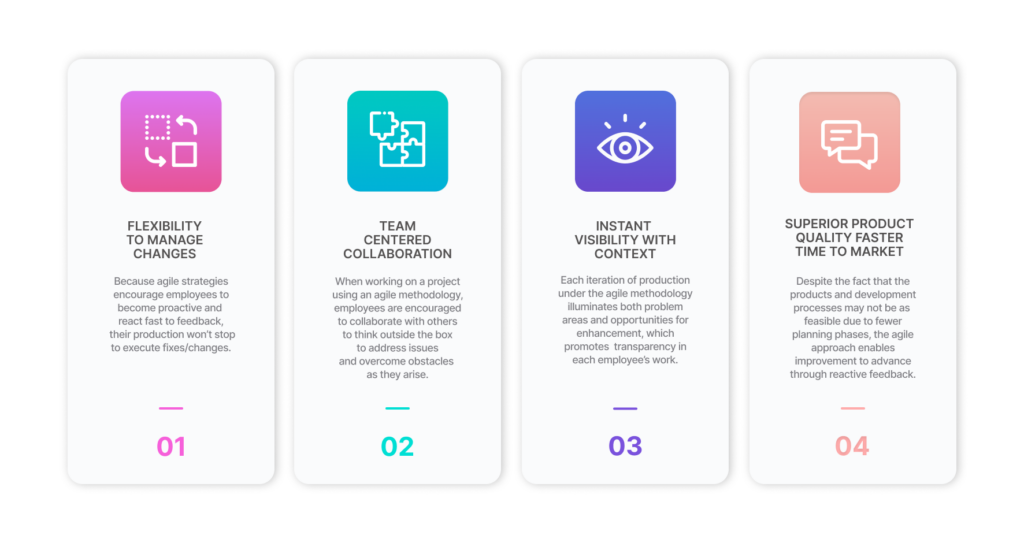The world is changing at a rapid pace. The advent of technology is just taking speed and people are using cutting edge project management technology almost every second of the day.
But do you really know what’s happening in this fast paced life? Many of us don’t have regular 9 to 5 jobs anymore, and instead work on projects with short deadlines. We are trying to be more productive so we can finish projects with quality and on time.
Unfortunately, few know about agile project management, which makes you a more efficient project manager.
What is agile project management?
In Agile methodology, teams deliver projects in iterations and refactor code. They also use automated tests to continuously integrate the entire project over time.
This iterative software development approach uses several techniques such as test-driven development (TDD) or pair programming to reduce the amount of time spent on formal requirements documentation. It also encourages continuous integration (CI), automated unit testing and other practices by performing regular releases to obtain customer feedback earlier in the project cycle.
Agile methodology supports “planning in little chunks” contrasted than waterfall project management, which plans the entire project before starting.
Key components of agile project management
There are 5 elements that glue an agile project together:
User Stories
User story is a tool for documenting the user’s perspective on a software product and the desired outcome of the project. Scrum teams employ the iterative development method known as “sprints” to complete each iteration of work on a user story.
Sprints
A sprint is a short-term iterative development process. The team completes a set of prioritised user stories in a sprint, which normally lasts 1-4 weeks. The purpose of a sprint is to deliver functional software that meets the user stories’ requirements.
Stand-up meetings
Daily scrums, also known as stand-up meetings, are brief, daily meetings where team members share information about their progress, any obstacles they are facing, and their upcoming tasks. The goal of these meetings is to keep the team aligned and informed about the project’s status.
Agile board
Agile boards track project progress visually. It is typically a physical board or a digital tool that displays user stories, tasks, and their respective statuses. The team uses the board to track progress, identify problems to fix, and ensure the project stays on track.
Backlog
A backlog is a list of user stories, tasks, and bugs that the team needs to handle in the project, ranked by priority. The team plans and sorts their work using the backlog, deciding what to work on next and prioritizing the most critical items.
The 8 steps in the agile project management of Snappymob
Project Planning
This is the first step in Agile project management, where clients will put in a request, after which the project team will identify the project’s goals and objectives, and develop a high-level product strategy to achieve them. This includes identifying the stakeholders, defining the project scope, and creating a timeline and budget.
Product Roadmap Creation
After defining project goals and objectives, the team will gather customer request details and establish a product roadmap. The product roadmap lays out the key milestones and deliverables, and serves as a guide for the team throughout the project.
Release Planning
The goal of release planning is to map out exactly how a specific set of features or capabilities will be delivered to the end user. Feature selection, delivery schedule, and testing and rollout procedures are all part of the release process.
In this step, the project management team will have discussion with all involved teams: Design team about using the right UI and design system; The QA team about the upcoming test execution and planning; and the Development team about their overall code building workflow. Hereafter, they will come up with a time estimate for all stakeholders, and wait for the client’s approval.
Sprint Planning
The Snappymob team plans the current and forthcoming sprints for two weeks during sprint planning. This includes selecting tasks, allocating team members, and building a sprint backlog.
As this is a continuous process, all involved teams will be participating in a constant sharing session about their progress thus far. Shortly after, the project team would exhibit any available UX as a process gauge to reach the client’s deadline.
Daily Stand-ups
Daily stand-ups, also known as daily scrums, are short meetings held at the beginning of each day where team members give updates on their progress, obstacles, and goals for the day.
Then, the project team will hold meetings with the clients to demonstrate their progress at intervals determined by how frequently the clients request updates.
Sprint Review and Demo
The sprint review step is where the project management team showcases the work that was completed during the sprint to the stakeholders. This includes reviewing the completed tasks, identifying any issues or risks, and planning for the next sprint.
In Snappymob, members of the Design team will present their complete UI/UX designs and layouts, while the our developers will give a run-through of their code review. Keep in mind that if problems persist, the “staging” process will begin again.
Project Testing
Our QA engineers are tasked to ensure all bugs are fixed after the project demo, also known as the alpha testing stage. After all bugs are fixed, the project will go through its beta testing stage by its users.
After gathering customer input and software usage statistics, the project will begin user acceptance testing (UAT). Which means that the end users will take ownership of the project to test the software’s functionality before deciding whether to give approval for the project.
Acceptance
For the final stage of software development, the clients will be giving their acceptance on the project. This validates the software’s functionality and allows public use.
Agile methodology frameworks
Ready to take your project management to the next level? With Agile, you have a variety of frameworks to choose from to best suit your project needs:
Lean
Do not mistake lean for agile and vice versa! This framework is based on the principles of the Toyota Production System and focuses on continuous improvement, waste reduction and maximizing value.
Scrum
One of the most popular and widely used is Scrum. Led by a scrum master, perfect for software development with its cross-functional team and short sprints for incremental improvements.
Kanban
This framework focuses on visualizing work and limiting work-in-progress to improve flow and reduce lead time. It is often done by using sticky notes on whiteboards or note-taking through online apps.
Extreme Programming (XP)
It is all about the practice of software development and places an emphasis on communication, feedback, and simplicity. Every software update will be based on client feedback, and developers will regularly test out new, cutting-edge features.
Feature Driven Development (FDD)
FDD is focused on delivering small, measurable, and testable increments of functionality. It emphasizes the active involvement of the stakeholders in the development process. The documentation requirements are more stringent than XPs, hence it’s best for teams with strong planning and design skills.
Crystal
This framework focuses on interactions, people, community, skills and talents. Therefore, if a team is geographically dispersed and cannot engage in continuous communication and reflection, this framework will fail.
Benefits of agile development
Below are some of the benefits you’ll get by implementing agile project management to your business development.

Q&A with our Project Managers
We had our project management team to answer some burning questions from the public:
Q: What are the core principles you used to communicate with your stakeholders?
A: “When communicating with our internal team, we put an emphasis on transparency and clarity. In order to foster more cooperation and cohesion, it is imperative that all members provide frequent updates when necessary, provide relevant information, and maintain open lines of communication.”
Q: How does our team handle sprint planning and daily stand-up meetings?
A: “We always plan with a detailed product roadmap by breaking down needs into manageable chunks. This is to ensure that our goals are realistic and attainable; We add nothing unmeasurable. Consequently, we hold weekly stand-ups to discuss our accomplishments, roadblocks, and goals.”
Q: How do we prioritize and manage the backlog of tasks for each project?
A: “Depending on our client’s priority, we will rearrange and execute the backlog of each project. Some bugs may have zero impact on the software’s functionality, for instance, thus they will not be of top priority within the backlog files.”
Q: How do we handle changes or unexpected issues that arise during a sprint?
A: “If clients request modifications, we will first assess the scope of the request and then submit it to the commerce side for a quote before proceeding with the revisions. If the issue is urgent, then the project management team will take care of it immediately; while less pressing ones will be placed into backlogs.”
Q: How do we incorporate user feedback and testing into our Agile process?
A: “The team will speed up the agile process to meet the needs of urgent requests. Basically, the team’s reporting to clients will vary in terms of speed, as required by the clients.”
Wrapping up
The agile process has numerous benefits in for your business. It saves time and money, improves overall project quality, and better manages the end-to-end process as well.
At Snappymob, our team has successfully integrated this methodology into their project management processes. Every project is handled with care to ensure its success.
Looking to enhance the process of your next project? Look no further, we’ve got just the right expertise to assist you today!
